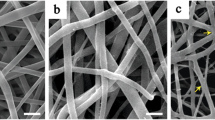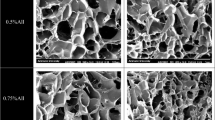Abstract
Purpose
A 3wt% poly(L-lactic acid) (PLLA) with different concentrations of polyethylene glycol (PEG, 0~9wt%) was blended and lyophilized to evaluate the morphology and the biocompatibility of the PLLA/PEG scaffolds. The purpose of this study is to investigate the biocompatibility of the PLLA/ PEG blends. Morphology, degradation rate, cytotoxicity, skin sensitization, acute systemic toxicity, and intradermal reactivity are examined.
Methods
The morphology of the scaffolds was examined by using scanning electron microscopy. The degradation of the scaffolds in phosphate buffer solution was measured for up to 9 weeks by measuring the weight loss. The extract test method was conducted on the scaffolds to evaluate the potential of cytotoxicity on the base of the International Organization for Standardization (ISO 10993-5). Skin sensitization, acute systemic toxicity, and intradermal reactivity were conducted according to ISO 10993-10(2010), ISO 10993-11(2006), ISO 10993-10(2010), respectively.
Results
The lamellar morphology of PLLA scaffold was changed to the ladder-like structure with adding PEG. The pore size of the PLLA/PEG blends decreased from 24±6 μm to 13±2 μm with increasing the PEG content from 0wt% to 9wt%. As a result of the measurement, degradation rate rose with increasing the PEG content in PLLA and biodegradable PLLA/PEG blend scaffolds exhibited excellent biocompatibility due to the absence of cytotoxicity, skin sensitizing potency, acute systemic toxicity, and intradermal reactivity.
Conclusions
This outcome implied that the biodegradable PLLA/PEG scaffolds were clinically safe and effective.
Similar content being viewed by others
References
Kim HD, Bae EH, Kwon IC, Pal RR, Nam JD, Lee DS. Effect of PEG-PLLA diblock copolymer on macroporous PLLA scaffolds by thermally induced phase separation. Biomaterials. 2004; 25(12):2319–29.
Ma PX, Choi J. Biodegradable polymer scaffolds with welldefined interconnected spherical pore network. Tissue Eng. 2001; 7(1):23–33.
Schugens Ch, Maquet V, Grandfils C, Jerome R, Teyssie Ph. Biodegradable and macroporous polylactide implants for cell transplantation: 1.Preparation of macroporous polylactide supports by solid-liquid phase separation. Polymer. 1996; 37(6):1027–38.
Li J, Chen Y, Mak AF, Tuan RS, Li L, Li Y. A one-step method to fabricate PLLA scaffolds with deposition of bioactive hydroxyapatite and collagen using ice-based microporogens. Acta Biomater. 2010; 6(6):2013–19.
Hwang S, Todo M. Characterization of compressive deformation behavior of multi-layer porous composite materials for articular tissue engineering. J Mech Sci Technol. 2012; 26(7):1999–2004.
Deplaine H, Ribelles JLG, Ferrer GG. Effect of the content of hydroxyapatites on the properties and bioactivity of poly(Llactide)-Hybrid membranes. Comp Sci Technol. 2010; 70(13): 1805–12.
Gaona LA, Gomez Ribelles JLG, Perilla JE, Lebourg M. Hydrolytic degradation of PLLA/PCL microporous membranes prepared by freeze extraction. Polym Degrad Stabil. 2012; 97(9):1621–32.
Xing Q, Dong X, Li R, Yang H, Han CC, Wang D. Morphology and performance control of PLLA-based porous membranes by phase separation. Polymer. 2013; 54(21):5965–73.
Liu YS, Huang QL, Kienzle A, Müller WEG, Feng QL. In vitro degradation of porous PLLA/pearl powder composite scaffolds. Mater Sci Eng C. 2014; 38(1):227–34.
Kim J, Lee DY, Kim T, Song Y, Cho N, Biocompatibility of hyaluronic acid hydrogels prepared by porous hyaluronic acid microbeads. Met. Mater. Intl. 2014; 20:555–63.
Kim J, Lee DY, Kim E, Jang J, Cho N. Tissue response to implants of hyaluronic acid hydrogel prepared by microbeads. Tissue Eng Regen Med. 2014; 11(1):32–8.
ISO 10993-11:2006, Biological evaluation of medical devices-Part 11: Tests for systemic toxicity. In: ISO/TC 194 Biological and clinical evaluation of medical devices. International Organization for Standardization. 2006. http://www.iso.org/iso/catalogue_detail.htm?csnumber=35977. Accessed 21 Nov 2016.
Shasteen C, Choy YB. Controlling degradation rate of poly(lactic acid) for its biomedical applications. Biomed Eng Lett. 2011; 1:163–7.
Kim JH, Noh H, Kang JH, Lee BS, Choi J, Park K, Han DK. Characteristics of PLLA films blended with PEG block copolymers as additives for biodegradable polymer stents. Biomed Eng Lett. 2011; 1(1):42–8.
Author information
Authors and Affiliations
Corresponding author
Rights and permissions
About this article
Cite this article
Kim, Y., Son, S., Chun, C. et al. Effect of PEG addition on pore morphology and biocompatibility of PLLA scaffolds prepared by freeze drying. Biomed. Eng. Lett. 6, 287–295 (2016). https://doi.org/10.1007/s13534-016-0241-3
Received:
Revised:
Accepted:
Published:
Issue Date:
DOI: https://doi.org/10.1007/s13534-016-0241-3




